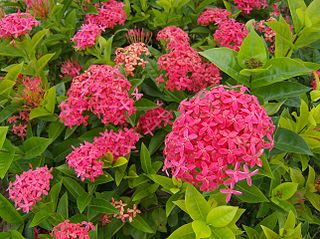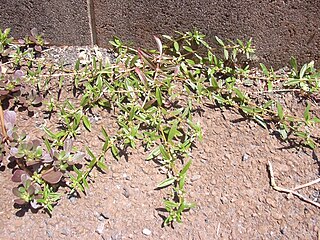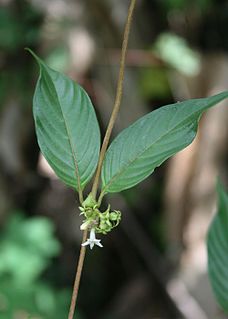
The Rubiaceae are a family of flowering plants, commonly known as the coffee, madder, or bedstraw family. It consists of terrestrial trees, shrubs, lianas, or herbs that are recognizable by simple, opposite leaves with interpetiolar stipules and sympetalous actinomorphic flowers. The family contains about 13,500 species in about 620 genera, which makes it the fourth-largest angiosperm family. Rubiaceae has a cosmopolitan distribution; however, the largest species diversity is concentrated in the tropics and subtropics. Economically important species include Coffea, the source of coffee, Cinchona, the source of the antimalarial alkaloid quinine, some dye plants, and ornamental cultivars.

Uncaria is a genus of flowering plants in the family Rubiaceae. It has about 40 species. Their distribution is pantropical, with most species native to tropical Asia, three from Africa and the Mediterranean and two from the neotropics. They are known colloquially as gambier, cat's claw or uña de gato. The latter two names are shared with several other plants. The type species for the genus is Uncaria guianensis.

Gentianales is an order of flowering plants, included within the asterid clade of eudicots. It comprises more than 16,000 species in about 1,138 genera in 5 families. More than 80% of the species in this order belong to the family Rubiaceae.

Galium is a large genus of annual and perennial herbaceous plants in the family Rubiaceae, occurring in the temperate zones of both the Northern and Southern Hemispheres. Some species are informally known as bedstraw.

Manettia is a genus of flowering plants in the family Rubiaceae. There are between 80 and 123 species. They are distributed in the West Indies, Mexico, and Central and South America. Most are vines. The genus was named after Saverio Manetti.

Psychotria is a genus of flowering plants in the family Rubiaceae. It contains 1,582 species and is therefore one of the largest genera of flowering plants. The genus has a pantropical distribution and members of the genus are small understorey trees in tropical forests. Some species are endangered or facing extinction due to deforestation, especially species of central Africa and the Pacific.

Ixora is a genus of flowering plants in the family Rubiaceae. It is the only genus in the tribe Ixoreae. It consists of tropical evergreen trees and shrubs and holds around 562 species. Though native to the tropical and subtropical areas throughout the world, its centre of diversity is in Tropical Asia. Ixora also grows commonly in subtropical climates in the United States, such as Florida where it is commonly known as West Indian jasmine. Other common names include viruchi, rangan, kheme, ponna, chann tanea, techi, pan, siantan, jarum-jarum/jejarum, jungle flame, jungle geranium, and cruz de Malta, among others. The plants possess leathery leaves, ranging from 3 to 6 inches in length, and produce large clusters of tiny flowers in the summer. Members of Ixora prefer acidic soil, and are suitable choices for bonsai. It is also a popular choice for hedges in parts of South East Asia. In tropical climates they flower year round and are commonly used in Hindu worship, as well as in ayurveda and Indian folk medicine.

Oldenlandia is a genus of flowering plants in the family Rubiaceae. It is pantropical in distribution and has about 240 species. The type species for the genus is Oldenlandia corymbosa.

Guettarda is a plant genus in the family Rubiaceae. Most of these plants are known by the common name Velvetseed. Estimates of the number of species range from about 50 to 162. Most of the species are neotropical. Twenty are found in New Caledonia and one reaches Australia. A few others are found on islands and in coastal areas of the Indian and Pacific Oceans.

Lasianthus is a genus of flowering plants in the family Rubiaceae. They are tropical subshrubs, shrubs, or rarely, small trees. They inhabit the understory of primary forests. None of them are known to have any use.
Machaonia is a genus of flowering plants in the family Rubiaceae. It has about 32 species. All are indigenous to the neotropics. None has a unique common name. Some species have been called "alfilerillo", a Spanish name for the common and well-known genus Erodium. The type species for Machaonia is Machaonia acuminata.

Sabicea is a genus of flowering plants in the family Rubiaceae. They are known commonly as the woodvines. The type species is Sabicea cinerea. There are about 145 species. Most are distributed in tropical Africa and South America.

Rondeletia is a genus of flowering plants in the family Rubiaceae. It is endemic to the Neotropics. There are around 160 species.

Vanguerieae is a tribe of flowering plants in the family Rubiaceae and contains about 640 species in 28 genera. It is one of the most species-rich groups within the family and it is distributed all over the Paleotropics.

Kadua is a genus of flowering plants in the family Rubiaceae. It comprises 29 species, all restricted to Polynesia. Twenty-two of these are endemic to the Hawaiian Islands. Some of the species are common at high elevation. Others are single-island endemics or very rare, and a few are probably extinct. Kadua affinis is widely distributed in Hawaii and is polymorphic. The type species for the genus is Kadua acuminata.

Hillia is a genus of flowering plants in the family Rubiaceae. It has 24 species. All are indigenous to tropical America.

Ixoroideae is a subfamily of flowering plants in the family Rubiaceae and contains about 4000 species in 27 tribes.
Myrmephytum is a genus of myrmecophytic flowering plants in the family Rubiaceae. It is distributed from central Malesia to New Guinea.

Squamellaria is a genus of myrmecophytic flowering plants in the family Rubiaceae. It is endemic to the islands of Fiji.

Dr.Charlotte M. Taylor is a botanist and professor specialising in taxonomy and conservation. She works with the large plant family Rubiaceae, particularly found in the American tropics and in the tribes Palicoureeae and Psychotrieae. This plant family is an economically important group, as it includes plant species used to make coffee and quinine. Taylor also conducts work related to the floristics of Rubiaceae and morphological radiations of the group. Taylor has collected plant samples from many countries across the globe, including Chile, Colombia, Costa Rica, Panama, and the United States of America, and has named many new species known to science from these regions. As of 2015, Taylor has authored 278 land plant species' names, the seventh-highest number of such names authored by any female scientist.
















